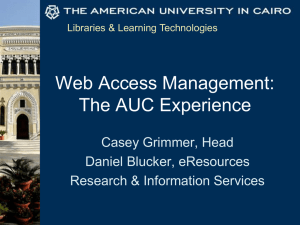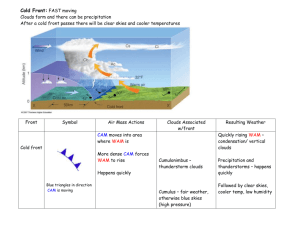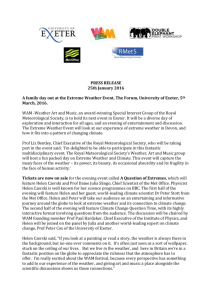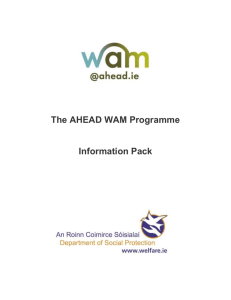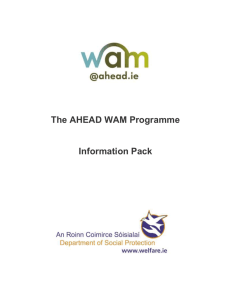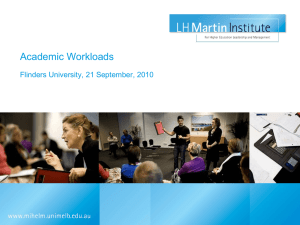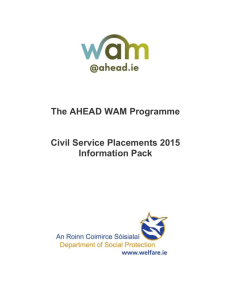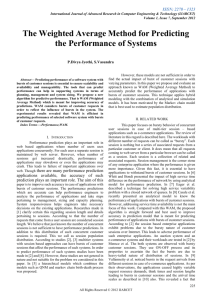Keele University Workload Allocation Model
advertisement
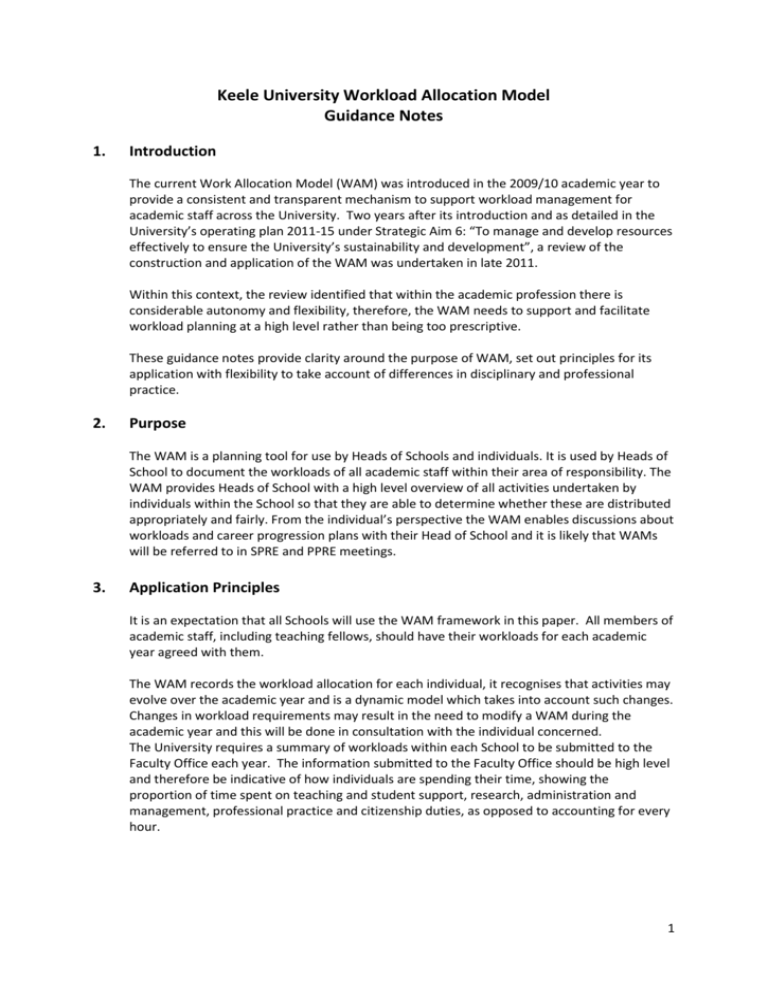
Keele University Workload Allocation Model Guidance Notes 1. Introduction The current Work Allocation Model (WAM) was introduced in the 2009/10 academic year to provide a consistent and transparent mechanism to support workload management for academic staff across the University. Two years after its introduction and as detailed in the University’s operating plan 2011-15 under Strategic Aim 6: “To manage and develop resources effectively to ensure the University’s sustainability and development”, a review of the construction and application of the WAM was undertaken in late 2011. Within this context, the review identified that within the academic profession there is considerable autonomy and flexibility, therefore, the WAM needs to support and facilitate workload planning at a high level rather than being too prescriptive. These guidance notes provide clarity around the purpose of WAM, set out principles for its application with flexibility to take account of differences in disciplinary and professional practice. 2. Purpose The WAM is a planning tool for use by Heads of Schools and individuals. It is used by Heads of School to document the workloads of all academic staff within their area of responsibility. The WAM provides Heads of School with a high level overview of all activities undertaken by individuals within the School so that they are able to determine whether these are distributed appropriately and fairly. From the individual’s perspective the WAM enables discussions about workloads and career progression plans with their Head of School and it is likely that WAMs will be referred to in SPRE and PPRE meetings. 3. Application Principles It is an expectation that all Schools will use the WAM framework in this paper. All members of academic staff, including teaching fellows, should have their workloads for each academic year agreed with them. The WAM records the workload allocation for each individual, it recognises that activities may evolve over the academic year and is a dynamic model which takes into account such changes. Changes in workload requirements may result in the need to modify a WAM during the academic year and this will be done in consultation with the individual concerned. The University requires a summary of workloads within each School to be submitted to the Faculty Office each year. The information submitted to the Faculty Office should be high level and therefore be indicative of how individuals are spending their time, showing the proportion of time spent on teaching and student support, research, administration and management, professional practice and citizenship duties, as opposed to accounting for every hour. 1 The model must be applied in a manner which is transparent and fair within a School, allowing for inequities in workloads to be identified and schools will publish the details of all individual WAMs in such a way that they may be accessible to all members of the School. An Equality Impact Assessment (EIA) should be undertaken, on a three yearly cycle, at School level to identify and address any adverse impact arising from the application of WAM, for protected groups. Reviews of workload allocation will be undertaken periodically at Faculty level. 4. The Model in Practice 4.1 Scope The WAM is applicable to all academic staff. It contains an estimation rather than a precise calculation of total workload by documenting the balance of activities which are undertaken by colleagues using a percentage breakdown of time. Workload may be allocated between some or all of the following areas (percentages in this section reflect normal expectations though there is flexibility for Heads of Schools and individuals to agree variations): Scholarship and personal development – 10% (all staff). The University is committed to supporting colleagues through providing opportunities for continuing professional development Organisation, Academic Administration and Citizenship – 20% (all staff). The University recognises that colleagues spend a significant proportion of time ensuring effective organisation and administration of academic activities. It is also expected that colleagues undertake a variety of citizenship duties. All colleagues will be allocated 20% of their time to such duties, which will be distributed by the Head of School and/or RI Director as appropriate. The remaining 70% of the time to be allocated between: Research. Based on RI buyout and postgraduate research students. Teaching and student support. Student contact, teaching and teaching related activity (For example only - lecturing, delivering seminars, personal tutoring and pastoral support, project / workshop / lab supervision, and supervision contact time relating to such activity. Pre and post-contact elements including preparing materials for teaching and planning teaching activity. Marking of essays and other written work and examinations. Organising and visiting student placements and fieldwork, including travel time) It is recognised that Schools will necessarily wish to use a ‘tariff’ for the fair distribution of teaching and student support activities. This would be based on Teaching and Student Support hours (TSS hours). As an indicator for each teaching contact hour there may be an additional 0-2 TSS hours. Enterprise Clinical and professional roles. Based on clinical programmed activities (PA) and the like Leadership .To cover major leadership roles (examples: Head of School; RI Director; Learning and Teaching Director; Programme Director – the size and scope of these roles and therefore the time allocation for these roles will vary between schools). 2 It is recognised that not all roles will include each of these aspects. 4.2 WAM at School Level There is flexibility within the WAM to adapt the model to suit the needs of individual Schools and in accordance with disciplinary norms. It is acknowledged that it will not always be possible to compare WAMs of academics from different schools. Heads of School will determine the most appropriate model for their school in consultation with members of staff within the School. Heads of School should consider how they may support early career academics when allocating workload. Heads of School will take lead responsibility for workload oversight, though they may delegate responsibility to others. Heads of School must ensure that appropriate communication and consultation is undertaken with RI Directors, Heads of Research Centres and Faculty Deans as appropriate. RI Directors will take lead responsibility for workload oversight for those academic staff who have substantial RI buy-out (normally over 60%). RI Directors/Heads of Research Centres will negotiate with Heads of School each year about individuals whose time will be supported in part by the RI, so that Heads of School may finalise the remaining workload allocation. Heads of School will then: Identify the teaching and administrative work which needs to be allocated for the year Assign teaching and student support, administration and management, professional practice and citizenship duties to each individual, and produce an individualised chart which shows how the workload (including research if appropriate) translates into percentage of time under the headings set out in 4.1. The School will send an indicative summary to the Faculty Office, using the standard template, on an annual basis once workloads have been agreed. 4.3 WAM at Faculty Level The Faculties require high level indicative information regarding the split of workload within each school detailed on an individual basis. The Faculty will provide schools with a template model to complete and agree dates by which the completed WAM should be submitted. The Faculty Office uses the WAM to broaden its understanding of the allocation of resources across the various areas to inform Faculty level priorities, activities and strategic planning. The metrics provided by WAM may also be used by the Faculty office as one of a range of inputs to inform discussions on staff resourcing. 5. WAM Review 3 There will be a review of the operation of this revised model during autumn 2014. Reviews will also be undertaken periodically by the Faculty office and if anomalies in workloads are identified then appropriate action can be taken. 4

